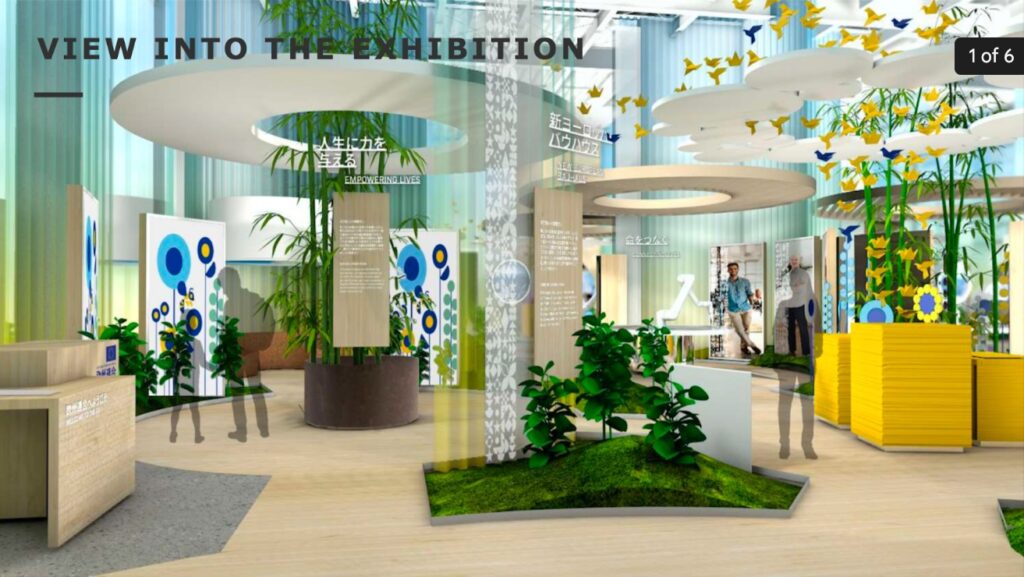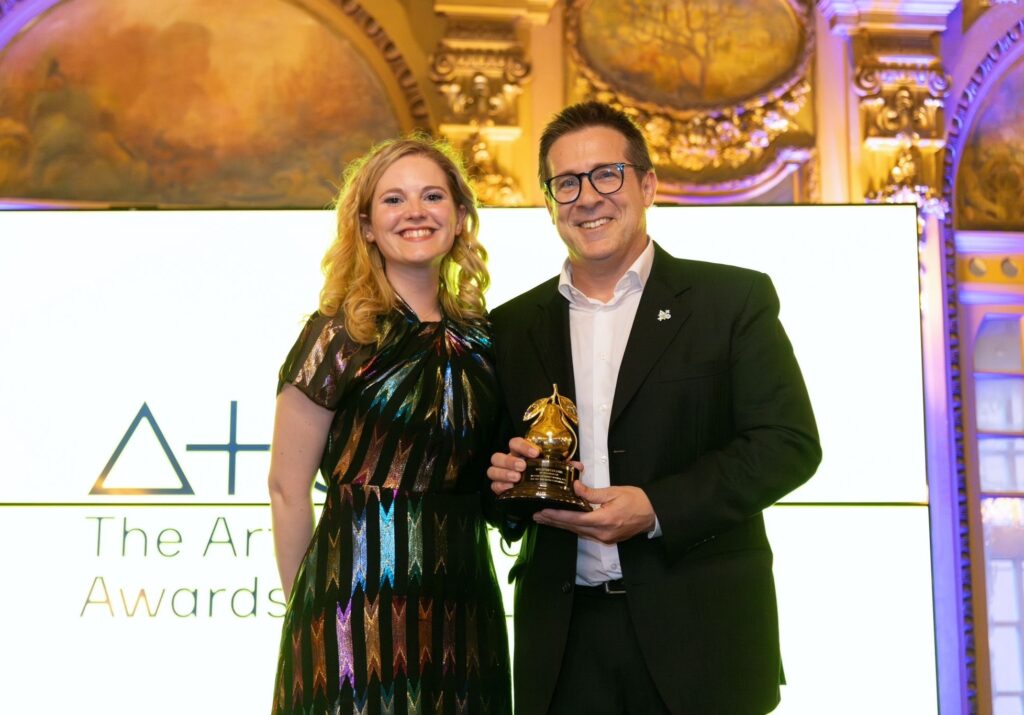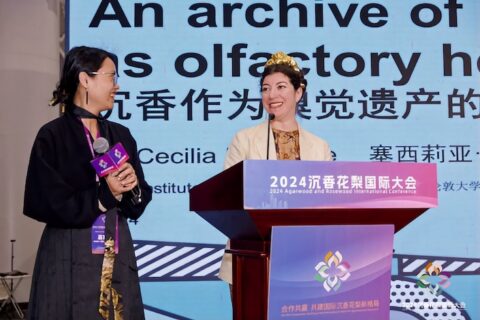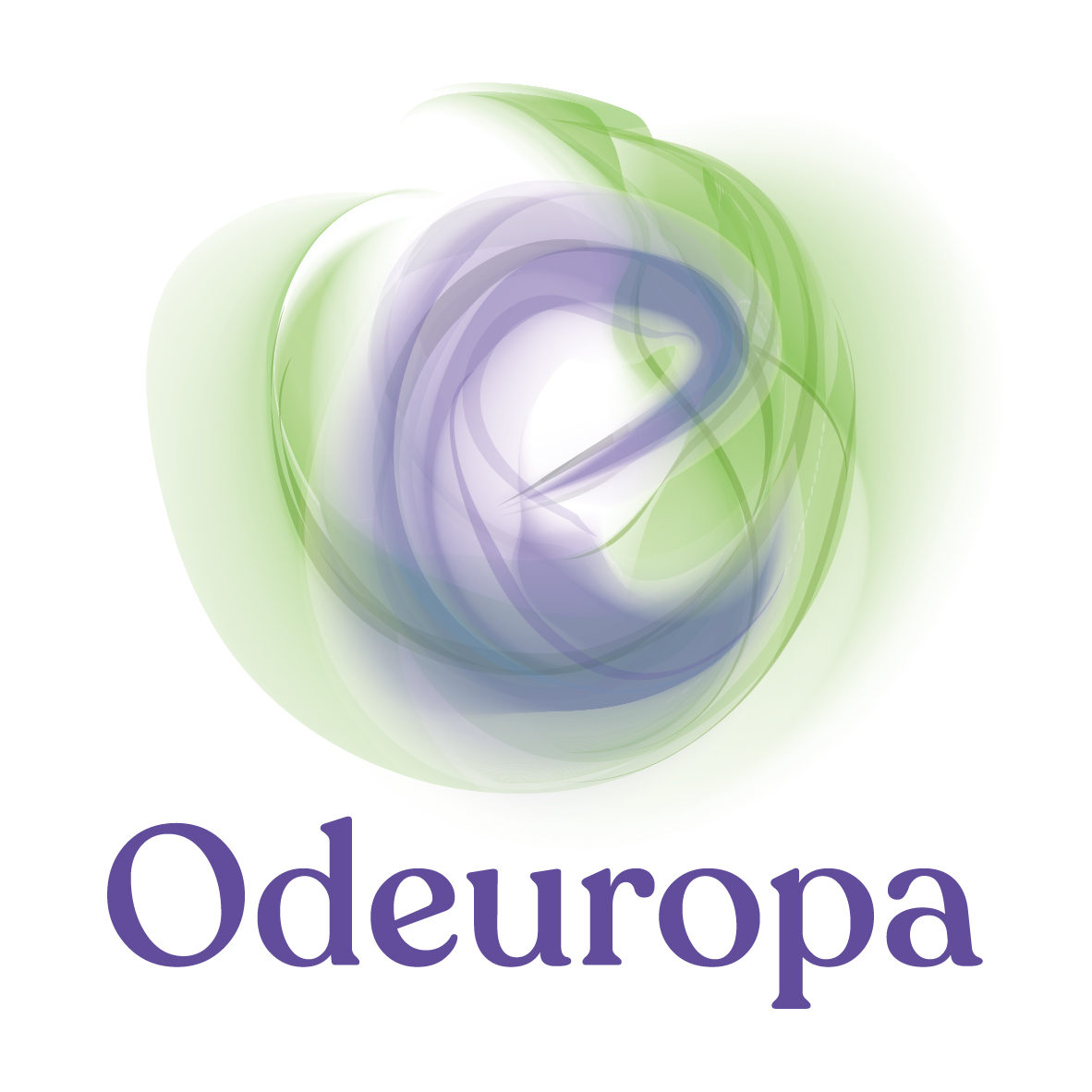Dear friends of Odeuropa,
It seems incredible, but it has already been well over a year since we celebrated the successful conclusion of our EU project at the Smell Culture Fair in Amsterdam in December 2023. But while the project has formally ended, the Odeuropa team never stopped their work in olfactory heritage and sensory mining.
We’ve been involved in many activities during this time and as a result we have a lot of news we want to share with you. To start off, three special highlights:
Odeuropa at the 2025 World Expo in Osaka, Japan
Odeuropa has been selected by the European Union to be featured in its pavilion at the World Expo in Osaka 2025! This is a great honour as we are one of only three research projects representing the EU in Osaka. Three members of the Odeuropa consortium (Raphael Troncy, Cecilia Bembibre, and Inger Leemans) will be travelling to Japan for one week in late April to participate in the Expo, present lectures, offer smellwalks, and visit several of the pioneering ‘100 most significant cultural smellmarks of Japan‘. But even after we return home, we will still be ‘present’ at the EU’s exhibition until the Expo ends, in the form of a AI-powered ‘visual avatar’ of our project lead which will interact with visitors to answer questions and explain Odeuropa in more detail. And of course the exhibit will also feature a number of heritage scents, generously supported by IFF.

Odeuropa wins Art and Olfaction Award
The Art and Olfaction Award is a highly competitive and selective international prize that is designed to raise interest and awareness for active independent, artisan and experimental perfumers from all countries. The awards are organised and run by The Institute for Art and Olfaction in Los Angeles. We were thus delighted to find out last year that we had become the recipient of the 2024 Art and Olfaction award for “Contribution to Scent Culture”. Sofia Colette Ehrich (Odeuropa) and Bernardo Fleming (IFF) were present at the award ceremony in Lisbon to accept the ‘Golden Pear’ on behalf of the entire Odeuropa team.

SmellWise Doctoral Network Application
Last autumn, we submitted a large, consortial application with 21 European partners for an EU Marie Skłodowska-Curie Doctoral Network (SmellWise: Training Experts in Smell Culture and Olfactory Heritage) on scent education.

SmellWise aims to address the historical neglect of olfaction in European knowledge culture by training 12 PhD candidates over 36 months (2026-29) to become experts in smell culture and olfactory heritage. The initiative will bring together academia, fragrance industries, cultural heritage institutes, and creative sectors to develop innovative frameworks and technologies for researching and educating about smell as a cultural phenomenon. By offering specialized training in perfumery, smell history, AI-driven odor analytics, neurobiology, heritage science, scent design, and olfactory storytelling, SmellWise aspires to produce a new generation of “smellwise” experts capable of integrating diverse knowledge domains to enhance public appreciation of olfaction’s role in wellbeing, cultural practices, and sustainable development. We should hear the outcome of this grant application in the Spring. The EU Doctoral Network is a highly competitive funding scheme – but we’re holding our thumbs!
We still have a great deal more news to share so we’ve collected these as brief notes in the sections below:
Olfactory Heritage and Storytelling
- The Historical Scent Collection has been distributed to a number of different GLAMs and creative partners who are now working with the smell kit. For example, the new art gallery “Nāsī” (literally – in the nostril) opened its doors in creative house “Viskaļi” in Rīga, Latvia with an exhibition showcasing the smells in the Odeuropa historical scent collection and by paintings inspired by the scents by the artist Santa Kristiana Krūze.
- Odeuropa has undertaken the mission to store a Heritage Library with the Osmothèque International Archive of Perfumes: As this is an unprecedented step for the fragrance industries / olfactory artists and the Osmotheque, it took us some time to develop the format. But we are now happy to announce that the contracts by the major parties have all been signed and so we can move forward with the planning of the launch
- In the province of Frisia, in the Netherlands, the ‘sounds and smells of the countryside’ have been added to the heritage policy agenda. The Dutch Odeuropa team is forming a research group in collaboration with the Fryske Akademy and the Meertens Institute, to investigate heritage smells in Frisia.
- With IFF, we are planning an olfactory exhibit with the Henriette Polak Museum in Zutphen, the Netherlands for 2025 – the exhibit is specifically targeted for children to engage with modern art.
- Dutch artist Boris van Berkum has been installed as a guest researcher at KNAW Humanities Cluster, to work on his project Eau de Colonial.
- Sofia Collette Ehrich is collaborating with the Missouri Botanical Garden’s Stephen and Peter Sachs Museum on a multisensory activity for their exhibition Smelling The Bouquet: Plants and Scents in the Garden set to open May 2nd, 2025. Ehrich and curator Nezka Pfeifer will speak about the collaboration at Museum Next’s Museums & Public Programs Summit in May.
- The International Fragrance Association UK is hosting its first olfactory heritage event on June 12th 2025. Scents of Time, hosted by Odeuropa members Will Tullett and Cecilia Bembibre, will convene perfumers, heritage professionals and policy makers to explore the landscape of smell heritage in the United Kingdom.
New projects and proposals related to Odeuropa
- Odeuropa’s sister project POEM (The Poetics of Olfaction in Early Modernity) is moving towards its second year. 15 November 2024 we organized a workshop on ‘Odeurs Trouvées: How smell can boost the impact of teaching literature in secondary schools. POEM has now also published a call for proposals for a conference on The Poetics of Olfaction, 1500–1800 which will be held 28–29 January, 2026 in Leiden. The project has just opened a new position for a postdoctoral researcher.
- The Dutch National Board for Heritage Research (NOE) is helping to draft a strategic agenda for the coming 5 years in which sensory heritage will be included as an urgent theme.
- Dr Will Tullett has collaborated with Dr Xuelei Huang at the University of Edinburgh on the Royal Society Edinburgh funded project The Smell of Scotland, which has involved three workshops with GLAMs in Scotland on the smells interaction with urban, culinary, and botanical heritage.
- The Knowledge Transfer Office of the KNAW and the Vrije Universiteit IXA subsidy desk are helping us to set up a legal entity for olfactory storytelling in a heritage context. It’s a slow process, but we are also making good steps here.
Lectures and Presentations
- Inger Leemans presented a keynote lecture for CIDOC 2024 in the Rijksmuseum, Amsterdam for the International Council of Museums (ICOM) community and gave a presentation at the 2024 Amsterdam Light Festival on smells and rituals. She also gave a keynote lecture at the 2024 Affective and Emotional Dimensions of Experience conference at the Catholic University at Braga, in Portugal.
- Caro Verbeek, Frank Bloem, and Inger Leemans gave a nose-on lecture at the Geschiedenisfestival (history festival) highlighting the work done for the Neuswijzer book.
- Sofia Collette Ehrich presented a lightning talk on experimental scent in museums at the Institute for Art and Olfaction’s 2024 Experimental Scent Summit.
-
Cecilia Bembibre presented Odeuropa at the International Rosewood and Agarwood Conference in Hainan, China, in November 2024 (pictured below)

- Victoria-Anne Michel was part of the organisation of the exhibition and conference Les Odeurs Capitales, held by the air quality monitoring association in Normandy, ATMO Normandie.
- Vincent Christlein presented “How to see smells in artworks?”, at Pint of Science, Kilians Pub, Nuremberg
- Inger Leemans helped to organize and gave a nose-on presentation for the academic forum on the Spice Route together with Indonesian embassy and Negeri Rempah foundation which is striving to add the Spice route to the UNESCO world heritage listings.
- Pasquale Lisena showcased a demo with the title of “Multisensory AI with Odeuropa”, focusing on the Odeuropa Smell Explorer, at the World AI Cannes Festival (WAICF)
- Will Tullett will be giving a keynote at the University of Cambridge conference ‘Scents and Imagination’ in June.
Awards and Recognition
- Odeuropa’s project leader, Inger Leemans, was nominated as one of six finalists in the Netherlands in 2024 for the prestigious Huibregtsen Prize. The prize is awarded for a recent research project that combines scientific quality and innovation with significant societal impact. (please see short video of our project)
- Odeuropa was nominated by Research Data Netherlands as one of three finalists in the Humanities and Social Sciences for the 2024 Dutch Data Prize for its work on the European Olfactory Knowledge Graph.
Publications
- Zinnen M., Christlein V.: “Odeuropa und der Duft der Bilder”, In: Schönere Heimat (2024), p. 225-229, ISSN: 0177-4492, https://heimat-bayern-kaufladen.de/Schoenere-Heimat-2024-Heft-3/SW10437
- Patoliya, V., Zinnen, M., Maier, A., Christlein, V.: Smell and Emotion: Recognising Emotions in Smell-related Artworks (2024), in: DH2024, https://arxiv.org/abs/2407.04592
- Mathias Zinnen, Prathmesh Madhu, Inger Leemans, Vincent Christlein et al., ‘Smelly, dense, and spreaded: The Object Detection for Olfactory References (ODOR) datase’t, Expert Systems with Applications 255(87) June 2024:124576. https://dl.acm.org/doi/10.1016/j.eswa.2024.124576
- Hussian, A., Zinnen, M., Tran, TMH, Maier, A., Christlein, V.: “Gesture Classification in Artworks Using Contextual Image Features”. In: DH2024. https://cris.fau.de/publications/330523845/
- Huang H., Zinnen M., Liu S., Maier A., Christlein V.: “Scene Classification on Fine Arts with Style Transfer” In: SUMAC ’24: Proceedings of the 6th workshop on the analySis, Understanding and proMotion of heritAge Contents 2024, https://dl.acm.org/doi/10.1145/3689094.3689468
- Ehrich, S. C. “Crafting Intentional Scents: Enriching Cultural Heritage with Educational Olfactory Reproductions” In: Amsterdam Museum Journal. Edition #3 (RE)PRODUCTION. https://assets.amsterdammuseum.nl/downloads/Sofia-Collette-Ehrich.pdf
- Liu S., Huang H., Zinnen M., Maier A., Christlein V. “Novel Artistic Scene-Centric Datasets for Effective Transfer Learning in Fragrant Spaces”. In: ECCV 2024 Workshops. ECCV 2024. Lecture Notes in Computer Science. https://arxiv.org/abs/2407.11701
- Menini S. “Semantic Frame Extraction in Multilingual Olfactory Events”. In Proceedings of the 2024 Joint International Conference on Computational Linguistics, Language Resources and Evaluation (LREC-COLING 2024), pages 14622–14627, Torino, Italia. ELRA and ICCL. https://aclanthology.org/2024.lrec-main.1273/
Press Coverage
We continue to get attention from the press, even after the end of the project:
- Culture: The Past Gives up its Secrets – CORDIScovery Podcast – 23 July 2024
- What did ancient cities smell like? – CORDIS News – 15 November 2024
- Comment les musées vous mènent par le bout du nez ? – La Tribune Dimanche – 14 January 2024
- Expos, visites olfactives… Les odeurs s’invitent au musée! – BeauxArts – 22 May 2024
- Odeuropa und der Duft der Bilder: Wie riecht Heimat? – Schönere Heimat – August 2024
- Il museo degli odori (podcast) – Millennium – 5 January 2025
- La (ri)scoperta dell’olfatto – Donna Moderna – 29 January 2025
- ‘Het zoete koekje heeft ook een donkere geschiedenis’ – Het Parool – 17 November 2024
- Wat Rembrandt Rook – OnsAmsterdam – 24 November 2024
- Onze oer-Hollandse speculaas staat voor gezelligheid, geweld én erotiek – Trouw – 3 December 2024
- The Times view on lost odours: scent from the past – The Times – 7 June 2024
- Scientists sniff out scents of the past—including the Queen’s Rover – The Times – 21 December 2024
- ‘Myrrh, conifer oil and … breakfast tea’ – The Conversation – 14 February 2025
And that’s it! And next time we promise not to wait so long before we share news of our events and activities with you.








